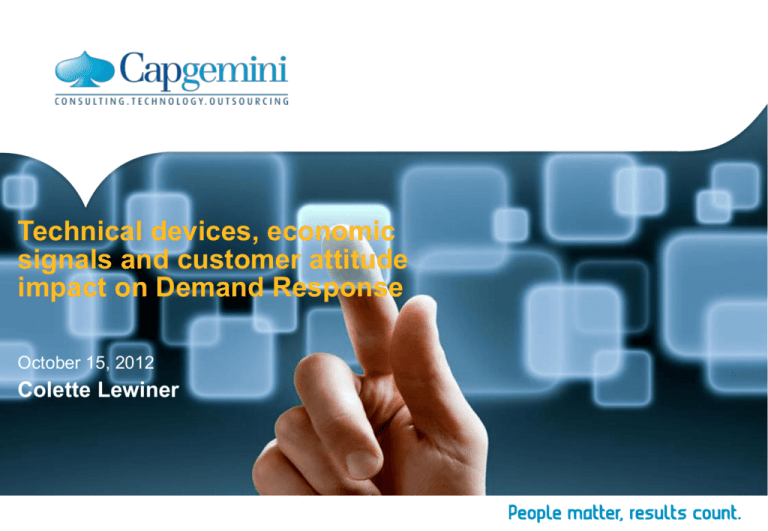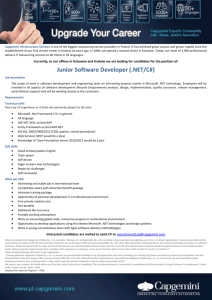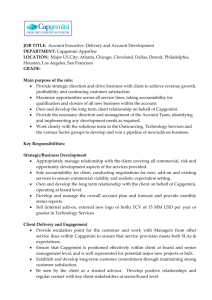
Technical devices, economic
signals and customer attitude
impact on Demand Response
October 15, 2012
Colette Lewiner
Status on the EU energy efficiency 2020 objectives
EU-27 primary energy consumption
EU-27 Primary energy consumption [Mtoe]
1,850
June 13, 2012 new Energy
Efficiency Directive:
• 17% decrease of EU’s primary
energy consumption by 2020
instead of 20%
• Requirement for Utilities to make
energy savings equivalent to
1.5% of their annual sales each
year from 2014 to 2020
1,800
1,750
1,700
-9%
1,650
1,600
1,550
1,500
1,450
1990
Historical evolution of primary energy consumption
Path to reach 2020 target
2020 target f or EU-27
Projection with current measures in place
(as per the March 2011 EU Energy Ef f iciency Plan)
New objective def ined in the June 2012 EU Energy
Ef f iciency Directive
1995
2000
2005
-17%
-20%
2010
2015
2020
Source: BP statistical report 2012, European Environment Agency, Eur’Observer – Capgemini analysis, EEMO14
Presentation Title | Date
Copyright © Capgemini 2012. All Rights Reserved
2
In countries as France and Japan, peak shaving is a
key issue during extreme weather conditions
• The French electricity peak load reached 102,100 MW at 19:00
• Nuclear plants’ availability largely contributed: 59,165 MW (55 reactors out of the 58
were in operation)
• France imported 7,845 MW from all its neighboring countries (max 9,000 MW)
• On EPEX Spot, day-ahead electricity prices jumped to €1,938/MWh
• RTE activated it EcoWatt demand response program in Brittany and PACA regions
which resulted in a consumption reduction of respectively 2% and 3%
• EnergyPool curtailed 20 MW of industrial consumption which have been used for
Brittany region
In 2011, net new generation capacities have been added:
• 850 MW of CCGT
• 1,250 MW of renewable energies
• 450 MW of fossil-fired plant have been decommissioned
New housing heating gas is regaining market share: close to 60% compared to
less than 40% for electricity in 2011 (2008 electrical heating market share was
70%). This has decreased the potential electricity demand at peak hours by 450
MW
But tariff-related demand response capacities have decreased from 6,000
MW in 2004 to 3,000 MW in 2011
Generation mix on February 8, 2012 at 19:00
Gas
Oil-fired + Coal
3%
5%
peak
capacities
5%
Imports
8%
Others
6%
Source: RTE
Nuclear
58%
Hydro
13%
Wind
2%
A holistic approach to manage the peak load needs to be implemented. It should encompass:
• Generation capacities development (including incentives for peak power)
• Demand response: tariffs or other types of demand response programs
• Incentives for energy savings
• Grids reinforcement
Presentation Title | Date
Copyright © Capgemini 2012. All Rights Reserved
3
Pilot programs results on peak shaving
% peak shaving observed in various pilots worldwide
Several means exist for
peak shaving and energy
savings, that can be
combined or not:
% peak shaving
Range of peak shaving
• Dynamic tariffs (that should
be further developed with
the mass roll-out of smart
meters)
• Automation such as smart
thermostat, smart
appliances, in-home
displays or web-based
consumer portal
• Demand management
programs such as
customers alerts, social
networks communication or
feedbacks through bills,
web, SMS, smart phones
Source: Capgemini Consulting
Peak shaving: the use of displays helps but the customers’ behavior is key
Presentation Title | Date
Copyright © Capgemini 2012. All Rights Reserved
4
Demand response potential for EU-27 by 2020
• GDP growth 2010-20: 1.8% in average
• CAGR electricity consumption 2010-20: 0.7%
• Some existing energy efficiency programs such as
Grenelle de l’Environnement or White Certificates
Assumptions are made on:
• Regulation (norms and standards, energy efficiency
objectives, tariffs and incentive policies)
• Market design (possibility to monetize DR on
wholesale markets, contracts optimization, capacity
markets)
• Smart meters penetration and functionalities (for the
households segment)
9.1
24
12%
22
20
18
3%
Forecast scenario (dark bars)
7.6
1.6
14%
2%
20
1.3
16
Dynamic scenario
6.4
18
14%
3%
12%
14
10
1.1
4.9
13%
13
13
11
12
7.6
0.8
8
13%
11 0.8
10
2.4
13%
6
6
0.6
4
0.3
2
0
0.1
1.9
3%
14%
0.4
5
0.4
% energy saving
CO2 emissions saving (in Mt)
3%
2%
% peak shaving
2%
4.4
14
12
Dynamic scenario (light bars)
21
5
3
0.3
0.1
1.7
2%
0.3
13%
1.1
1.3
2%
5
4 0.3
0.1
14%
14%
2%
4 0.2
2
4 2%
3 0.2
0.1
1.7
1.6
1.5
1.4
1.3
1.2
1.1
1.0
0.9
0.8
0.7
0.6
0.5
0.4
0.3
0.2
0.1
0.0
Savings in electricity consumption (in equivalent number of
major cities)3
In Capgemini Consulting’s Demand Response
(DR) study*, the potential of peak shaving and
energy savings is modeled on the basis of a
baseline scenario:
Savings in generating capacities (in number of power plants) 2
Demand Response study 2012 results snapshot
1 Normative hypothesis: 1 kWh saves 700g CO2 (average European value considering avoided peak
capacity is mainly gas-fired plants)
2 Expressed in equivalent of avoided consumption of large size cities (2 mio inhabitants and 150,000
commercials, average consumption of 8.2 TWh/year)
3 Expressed in equivalent of avoided construction of power plants (500 MW)
And typical DR offerings are modeled with
Source: Capgemini Consulting
hypothesis on their adoption by customers
Our study shows that peak shaving potential is significant
*Demand Response study 2012 - Capgemini Consulting,
while electricity savings potential is more limited
VaasaETT and Enerdata
Presentation Title | Date
Copyright © Capgemini 2012. All Rights Reserved
5
Clients marketing and segmentation is key for
successful Demand Response
EXAMPLES OF SEGMENTATION CRITERIA
• Sociological (behaviors…)
• Psychological (awareness to technology …)
• Economical (power purchase, energy bill …)
• Technical (type of heating system, of housing, …)
Customers awareness-raising is key for a sustained customers’ behaviors change
Presentation Title | Date
Copyright © Capgemini 2012. All Rights Reserved
6
Smart meters could be a Demand Response
enabler
Electricity and gas smart metering projects in Europe
Mass roll-out finalized
Norway
E
Mass roll-out by 2020 well-engaged
Mass roll-out probably not
completed by 2020
NO
G
NL
PL
DE
E
Legislation should be ready in 2012
Pilots run by all Utilities
Similar to electricity
CZ
G
SK
Decision for roll-out of 35
million smart meters by 2020
taken in 2011.
GreenLys pilot, decision for
mass roll-out by 2013
FR
Austria
E
G
AT
CH
IT
PT
Portugal
E
National roll-out under discussion
Several pilots under way
RO
Hungary
E
G
Legislation adopted in 2011
Legislation under discussion
BG
Italy
Spain
E
100% smart meters should be
implemented by end 2018
E
G
Source: ESMA, GEODE – Capgemini analysis, EEMO12, updated March 2012
In September 2011, France has
decided the mass roll out of 35
million meters from 2013 to
2020 but the starting date will be
delayed.
4 technologies experimented
for gas smart meters (18,500
meters) in France. Final mass
roll-out decision should be taken
in 2013
Czech Republic
HU
Legislation adopted in 2010.
SI
Pilots from 10,000 to
240,000 meters
Legislation under discussion
ES
Smart meter substitution plan
presented by the regulator
Several pilots (30,000 to
50,000 meters) run
50 trials from 10 to 115,000 meters
Nationwide roll out under discussion
Customers can opt in or out
Similar to electricity
Poland
LU
France
E
E
UK
BE
Mandatory nationwide
roll-out under discussion
Germany
LT
No legislation yet
Several business case
studies under way
Similar to electricity
G
E
LV
DK
IE
Estonia
EE
Deployment by several
DNOs. No national plan
Belgium
E
100% smart meters
FI
implemented in 2009
Denmark
Ireland
G
Legislation into effect. At least
80% roll-out by end 2013
SE
E
E National roll-out
planned for 2014-17
G Studies under way
for gas
E
E Legal framework for voluntary
installation adopted
Several pilots under way
E 27 million smart meters should
be implemented by 2020
G Similar to electricity
E
Sweden
Netherlands
UK
E
Finland
Draft regulation issued in Feb. 2011
80% roll-out by 2016, 100% by 2018
80% of electricity customers
in EU Member States should
have smart meters by 2020.
All countries required to
perform cost benefit analysis
by September 2012
100% smart meters
implemented in 2009
GR
80% smart meters to be
installed by 2016
Greece
E
G
Roll-out under way
Plans for extending the
electricity system to
water and gas meters
In Europe the Value
Chain unbundling
regulation, impacts
negatively the return
on smart meters
investment and slows
down decisions
Presentation Title | Date
Copyright © Capgemini 2012. All Rights Reserved
7
Time-of-Use tariffs are important DR triggers:
Ontario example
Regulated Time-of-Use tariffs (c$/kWh)
Lessons learned
SUMMER
2.4% peak shaving (on a 6-hour period, from 11:00
until 17:00)
5.7% peak shifting (on a 3 or 4-hour period)
Off-peak consumption shifting hardly quantifiable
WINTER
6% consumption reduction
WEEKEND
HOLIDAYS
Some peak consumption reductions haven’t been reported
(notably lighting) during off-peak periods
This dynamic tariff has an indirect effect on consumption
patterns
3% savings on bills under the dynamic tariff
(compared with the standard tariff)
75% customers have made bills savings
The dynamic tariff is promoted as a tool
allowing customers to analyze their
consumption and control their bills
This program resulted in peak shaving as well
as peak shifting
Presentation Title | Date
Copyright © Capgemini 2012. All Rights Reserved
8
Visual tariff signal has also a significant impact on
DR: Energy Orb example
“Energy Orb” from PG&E
(Pacific Gas and Electricity) is a
visual indications to clients
involved in energy demand
management programs
The device alerts business
customers before and during an
energy consumption reduction
period
Many technical devices exist to trigger consumption reduction. They are often
expensive and their profitability remains to be established. Customers are reluctant
to invest in these equipments and services and consumption reductions are not
always fitting their expectations
Presentation Title | Date
Copyright © Capgemini 2012. All Rights Reserved
9
About Capgemini
With more than 120,000 people in 40 countries, Capgemini is one
of the world's foremost providers of consulting, technology and
outsourcing services. The Group reported 2011 global revenues
of EUR 9.7 billion.
Together with its clients, Capgemini creates and delivers
business and technology solutions that fit their needs and drive
the results they want. A deeply multicultural organization,
Capgemini has developed its own way of working, the
Collaborative Business ExperienceTM, and draws on Rightshore ®,
its worldwide delivery model.
Rightshore® is a trademark belonging to Capgemini
www.capgemini.com
The information contained in this presentation is proprietary.
© 2012 Capgemini. All rights reserved.






